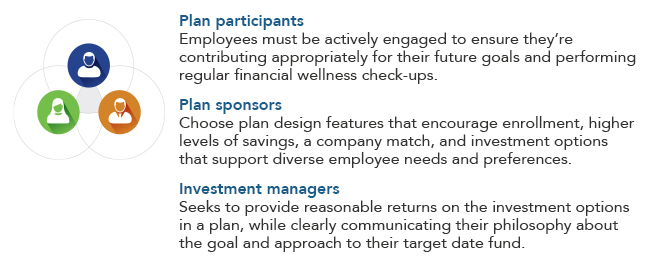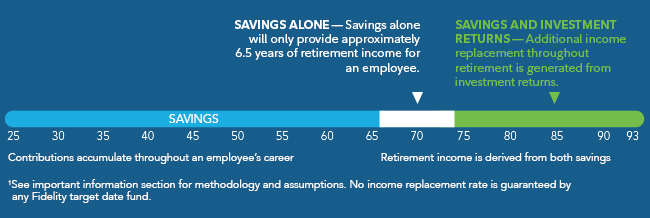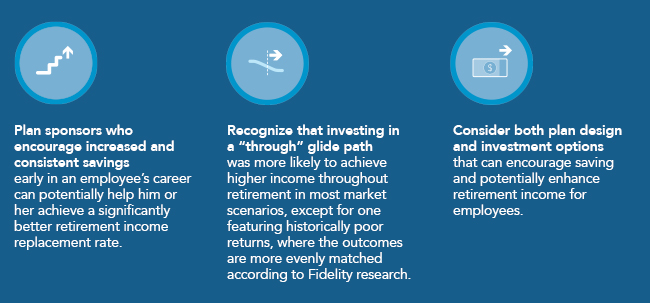Your benefits strategy should support your long-term workforce plans, which should include helping employees meet their retirement goals. To do that, it's important to recognize that there are three key contributors involved in achieving a desired level of retirement income through a workplace savings plan: the plan participant (eligible employee), plan sponsor, and the investment manager.
Key contributors to an employee's retirement readiness:
The importance of both savings and investment returns:
Employers should consider balancing risks when choosing “to” vs. “through” glide paths:
In a recent Fidelity study, we compared multiple widely adopted defined contribution plan designs with varying features to encourage enrollment and saving. We also evaluated the industry's two different types of target date funds—those with a glide path developed to reach its most conservative asset allocation at a specified retirement date (“to”) and those that will reach their most conservative point well into retirement (“through”)—in each plan design, to determine the impact of each on retirement income.
Comparing “to” vs. “through” glide paths

Plan design scenarios that maximize savings and used a “through” glide path resulted in higher retirement income replacement:
Our research examined three plan types: Baseline, Enhanced, and Increasing, in three market scenarios: average, poor, and lower-yielding market forecast. Although each plan design helps participants save for retirement, the ones that offered features to help participants boost their savings rates—an auto-enrollment rate, an annual increase program, and a company match—generated higher retirement income when combined with a target date fund with a “through” glide path.
Average Market Scenario Results2:
Key takeaways from the research:
Learn more about Fidelity target date funds and the importance of income replacement in glide path design. Download charticle now.
Important Information
Investing involves risk, including the risk of loss.
Internal rate of return (IRR) is the interest rate at which the net present value of all the cash flows (both positive and negative) from a project or investment equal zero.
1 Chart is a hypothetical example based on a set of assumptions to illustrate the limits of income replacement that can be achieved through regular savings contributions alone (white bar), and the need for an expected return on investment to achieve a desired level of income replacement over a longer retirement horizon (green bar). For the purposes of this chart, the following assumptions are presumed: investor starts contributing at age 25 through age 66, and receives annual salary increases equal to 1.5% over this period. The blue bar represents investor contributions increasing from 8% to 13% of salary from age 25 through age 66 (includes company matching funds). The white bar represents the expected income replacement provided solely by the contribution amounts, equal to approximately 50% of one's final preretirement salary through the early years of retirement. The green bar represents the expected income replacement needed through a target date portfolio's investment returns, equal to approximately 50% of one's final preretirement salary through age 93. A hypothetical internal rate of return (IRR) equal to approximately 4.5% in real terms is assumed (required investment return to have savings equal income replacement needs). This hypothetical illustration is not intended to predict or project the investment performance of any security or product. The IRR is a rate of return used in capital budgeting to measure and compare the profitability of investments. Past performance is no guarantee of future results. Your performance will vary, and you may have a gain or loss when you sell your shares. For many investors, these assets will be combined with other complementary sources of income (e.g., Social Security, defined benefit plan benefits, and personal savings). Source: Fidelity Investments as of July 1, 2016.
2 Assumptions used in this analysis – Participant: starting age – 25, retirement age – 67; retirement planning age – 93; starting salary – $50,000, final preretirement salary – $92,061 (1.5% annual increase). Glide paths: Fidelity's “through” glide path was used as a proxy for “through” glide paths in the marketplace; the “to” composite benchmark is an asset-weighted composite using the top “to” glide paths on Fidelity's Workplace Investing recordkeeping platform as of December 2015, including American Century, BlackRock, Franklin, John Hancock, JPMorgan, MFS, PIMCO, Putnam, State Farm, and USAA. “To” composite glide path data sourced from Morningstar, Inc., as of April 30, 2016. Plan design savings assumptions: Baseline – 6%; Enhanced – 9%; Increasing – approximately 15% on average over an investor's full career. Market return environments: average and poor historical markets use historical market data from Morningstar for period beginning 1926 through Dec. 31, 2015; lower-yielding market returns forecast scenario uses fixed returns of 5.9% for stocks, 1.8% for bonds, 0.1% for cash. Stocks (domestic), bonds, and short-term assets (cash) are represented by the S&P 500®, U.S. intermediate-term government bonds, and 30-day U.S. Treasury bills, respectively. Monte Carlo simulation: a mathematical method used to estimate the likelihood of a particular outcome based on market performance historical analysis. Historical performance simulations are conducted to determine the probability that a portfolio may experience a certain minimum level of performance given market volatility. Each Monte Carlo simulation reproduces a random set of results by generating a random return for the scenario. When analyzed together, these results suggest a probability of occurrence. For the purposes of our Monte Carlo simulations, we randomly generate a series of hundreds of returns for a given scenario. Monte Carlo 90% confidence level: means that in 90% of the historical market scenarios run, a similar equity glide path, performed at least as well as the results shown. Monte Carlo 50% confidence level: means that in 50% of the historical market scenarios run, a similar equity glide path, performed at least as well as results shown and 50% failed to reach the results shown. IMPORTANT: The projections regarding the likelihood of various investment outcomes are hypothetical in nature, do not reflect actual investment results, and are not guarantees of future results. Results may vary with each use and over time. The results generated are based on the assumptions indicated above and are for illustrative plan scenario analysis only; they are not intended for use by individual investors or plan participants. Source: Fidelity Investments.
3 100% match of first 3% and 50% match on next 2%.
Target date funds are designed for investors expecting to retire around the year indicated in each fund's name. The funds are managed to gradually become more conservative over time as they approach the target date. The investment risk of each target date fund changes over time as the fund's asset allocation changes. They are subject to the volatility of the financial markets, including that of equity and fixed income investments in the U.S. and abroad, and may be subject to risks associated with investing in high-yield, small-cap, and foreign securities. Principal invested is not guaranteed at any time, including at or after the funds' target dates.
Target date portfolios are designed to help achieve the retirement objectives of a large percentage of individuals, but the stated objectives may not be entirely applicable to all investors due to varying individual circumstances, including retirement savings plan contribution limitations.
Fidelity's “through” glide path may differ somewhat from those of other target date strategies, which could influence the results of the analysis in this article.
For plan sponsor and institutional use only.
Fidelity Brokerage Services LLC, Member NYSE, SIPC, 900 Salem Street, Smithfield, RI 02917
Fidelity Institutional Services Company, Inc., 500 Salem Street, Smithfield, RI 02917
© 2016 FMR LLC. All rights reserved.
768915.2.0
Complete your profile to continue reading and get FREE access to BenefitsPRO, part of your ALM digital membership.
Your access to unlimited BenefitsPRO content isn’t changing.
Once you are an ALM digital member, you’ll receive:
- Breaking benefits news and analysis, on-site and via our newsletters and custom alerts
- Educational webcasts, white papers, and ebooks from industry thought leaders
- Critical converage of the property casualty insurance and financial advisory markets on our other ALM sites, PropertyCasualty360 and ThinkAdvisor
Already have an account? Sign In Now
© 2024 ALM Global, LLC, All Rights Reserved. Request academic re-use from www.copyright.com. All other uses, submit a request to [email protected]. For more information visit Asset & Logo Licensing.














